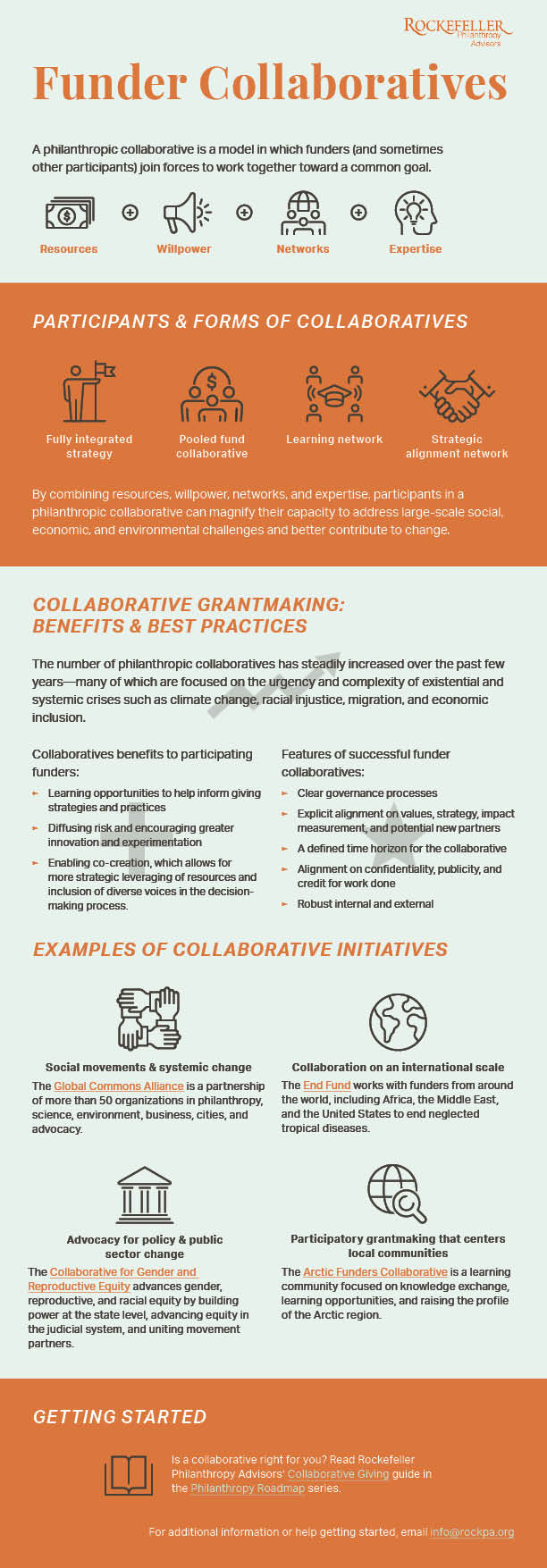Funder Collaboratives: A Topic Brief for Donors
December 02, 2021
Rooted in the notion that working together leads to greater impact, knowledge, and opportunity, a philanthropic collaborative is a model in which funders (and sometimes other participants) join forces to work together toward a common goal. By combining resources, willpower, networks, and expertise, participants in a philanthropic collaborative can magnify their capacity to address large-scale social, economic, and environmental challenges and better contribute to change.
Participants and Forms of Philanthropic Collaboratives
Funder collaboratives are not limited to a particular type or level of the funder. Individuals, families, foundations, corporations, and many others participate in this philanthropic model. Funder collaboratives sometimes also work with governmental entities, NGOs, think tanks, individual experts, and other organizations in the ecosystem to further their insight, reach, and impact.
Many collaboratives are hosted by an intermediary (such as Rockefeller Philanthropy Advisors), which can provide the expertise needed to start and sustain a successful collaborative, including establishing robust governance, managing grants, contributing issue-area expertise, and providing structure, oversight, and a neutral home.
Regardless of the exact constellation of participants, collaboratives can exist in a variety of formats. For example, funders may join a collaborative that has one fully integrated strategy, typically with decision-making authority resting with the lead funder. Meanwhile, in a pooled fund collaborative, participants contribute financial resources toward a common “pot” from which funds are distributed. One version of a pooled fund is a giving circle, which convenes individual funders to combine resources to support a specific organization or objective. In a learning network, another type of collaborative, funders come together to share information and strategies based on interests in a common field or issue area. Finally, in a strategic alignment network, funders make grants independently but work toward a shared and coordinated mission and strategy to obtain publicity, traction, and impact.
Collaborative Grantmaking: Best Practices, Challenges, and Benefits
Although various forms and traditions of collaborations have existed for a long time, the current funder collaboratives model has gained traction in the last decade in terms of formalizing concerted funding efforts, governance structures, strategic frameworks, and direct consideration of social dynamics and power relations at play. Moreover, the number of philanthropic collaboratives has steadily increased over the past few years—and many of those are focused on the urgency and complexity of existential and systemic crises such as climate change, racial injustice, migration, and economic inclusion. The funders coming together are typically focused on systemic, transformational impact, and have realized the need to coalesce different resources, experiences, knowledge, relationships, and more to maximize their impact.
Common approaches that contribute to the success of funder collaboratives, regardless of the issues the collaborative is created to address, include:
- Clear governance processes
- Explicit alignment on values, strategy, impact measurement, and potential new partners
- A defined time horizon for the collaborative
- Alignment on confidentiality, publicity, and credit for work done
- Robust internal and external communications and feedback mechanisms
In addition to enhanced external impact, collaboratives offer several meaningful benefits to the participating funders themselves. These include learning opportunities to help inform giving strategies and practices, as well as diffusing risk and encouraging greater innovation and experimentation. Collaboration also can, and increasing does, enable co-creation, which allows for more strategic leveraging of resources and inclusion of diverse voices and perspectives in the decision-making process.
However, it is important to note that even when there is alignment and clarity, collaboratives can face several unique challenges. For example, divergent priorities and visions over time, dissatisfaction with member roles and responsibilities, program fatigue, lack of trust, and limited resources are just some of the areas where even the best-planned collaboratives can struggle. To maximize the chances of success, it is important to acknowledge these hurdles and to reflect on, share, and incorporate lessons learned.
Examples of Collaborative Initiatives
Collaborative projects engage with a diverse range of issues and approaches, a few of which are highlighted below.
- Social movements and systemic change:
The Freedom Fund was initially created by three funders with the goal of ending modern slavery. Today, the collaborative receives funding from a variety of private foundations, individual benefactors, and members of the public, and works with more than 140 local partner organizations around the world to support advocacy, direct grantmaking, and movement building directed at driving systemic change and strengthening anti-slavery infrastructure globally.
The Global Commons Alliance (GCA) is a partnership of more than 50 organizations in philanthropy, science, environment, business, cities, and advocacy. The Alliance is focused on mainstreaming a science-based understanding of humanity’s critical dependence on the global commons, the existential threat posed by its tipping points, and the safe and just guardrails needed. A core mechanism of action for GCA is to scale the adoption and implementation of science-based targets for the global commons among companies and cities, including through engagement with governments. GCA’s unique capability is to facilitate the convergence of key actors around an equitable and systemic approach to stewarding the global commons through research, data, tools, and facilitation at local and global levels.
- Advocacy for policy and public sector change:
The Collaborative for Gender and Reproductive Equity believes that “by working together and pooling funds, [it] can be bolder, act faster and make a greater impact than any one donor can alone.” The funders include donors and foundations focused on advancing gender, reproductive, and racial equity through building power at the state level, advancing equity through the judicial system, and uniting movement partners.
- Collaboration on an international scale:
The End Fund works with funders from around the world, including Africa, the Middle East, and the United States to empower its mission to end neglected tropical diseases (NTDs) —are a group of parasitic and bacterial infectious diseases that affect more than 1.7 billion people. In addition to donations, the End Fund leverages donors to become long-term advocates and believe that the “energy, talent, impact and joy of the diverse community brought together by the END Fund has been, and will continue to be, a key driver of our unique contribution to the global movement to end NTDs.”
- Participatory grantmaking that centers the considerations of local communities:
The Arctic Funders Collaborative (AFC) is a learning community for grantmakers that focuses primarily on knowledge exchange, learning opportunities, and raising the profile of the Arctic region. The collaborative prioritizes the interests and involvement of Indigenous communities and works toward a model of locally-led growth for philanthropy in the region.
How to Get Started in Funder Collaboratives
Funders interested in pursuing a collaborative can start by reading Rockefeller Philanthropy Advisors’ Collaborative Giving guide in the Philanthropy Roadmap series. The guide provides a broad overview of the benefits, considerations, and pitfalls of participating in a funder collaborative, along with a variety of case studies to highlight the wide range of approaches to giving.
Experts at Rockefeller Philanthropy Advisors focused on funder collaboratives include Heather Grady. For additional information or help getting started, email [email protected].
Resources
Further reading:
- Collaborative Giving (Rockefeller Philanthropy Advisors)
- Approaches for Impact, Approaches for Learning (Shifting Systems Initiative)
- How Philanthropic Collaboratives Succeed and Why they Fail (Bridgespan)
- A Toolkit for Creating More Inclusive Funder Collaboratives (Fund for Shared Insight)
Infographic (Click to Expand)
Photo by Charles Forerunner on Unsplash
Back to News
